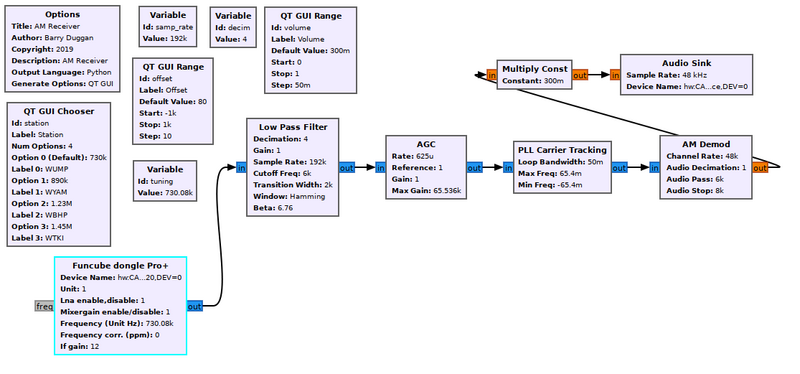PLL Carrier Tracking: Difference between revisions
Jump to navigation
Jump to search
(add notes to intro section) |
(add clarification) |
||
| Line 20: | Line 20: | ||
; Loop bandwidth (''R'') | ; Loop bandwidth (''R'') | ||
: The loop bandwidth determines the lock range and should be set | : The loop bandwidth determines the lock range and should be set in the range of pi/200 to 2pi/100 (0.0157 to 0.0628). | ||
; Max freq | ; Max freq | ||
: Maximum frequency of the carrier in radians per sample | : Maximum frequency of the carrier in <i>radians per sample</i>. See Notes above. | ||
; Min freq | ; Min freq | ||
: Minimum frequency of the carrier in radians per sample | : Minimum frequency of the carrier in <i>radians per sample</i>. See Notes above. | ||
== Example Flowgraph == | == Example Flowgraph == | ||
Revision as of 13:31, 28 October 2019
Implements a Phase Locked Loop (PLL) which locks to the carrier of the input frequency and outputs the input signal mixed with that carrier.
This PLL locks onto a [possibly noisy] reference carrier on the input and outputs that signal, downconverted to DC.
Notes
- Important: The frequency parameters below are in radians per sample rather than Hz.
- for example:
- input centered at 0 Hz.
- Sample rate = 48kHz.
- frequency variations to track +- 500Hz.
- Max freq = 0.0654
- Min freq = -0.0654
- for example:
- This block requires an input signal of at least -30db in order to lock to the carrier.
Parameters
(R): Run-time adjustable
- Loop bandwidth (R)
- The loop bandwidth determines the lock range and should be set in the range of pi/200 to 2pi/100 (0.0157 to 0.0628).
- Max freq
- Maximum frequency of the carrier in radians per sample. See Notes above.
- Min freq
- Minimum frequency of the carrier in radians per sample. See Notes above.
Example Flowgraph
This flowgraph shows the use of a PLL Carrier Tracking block in an AM receiver.
Source Files
- C++ files
- TODO
- Header files
- TODO
- Public header files
- TODO
- Block definition
- TODO
